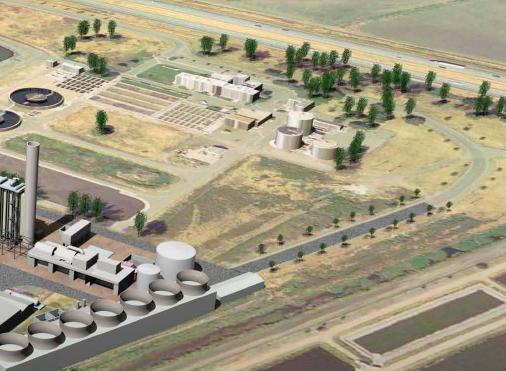
The Lodi Energy Center Project is scheduled for completion by mid-2012, which means that contractors will be racing the clock—and awaiting final design—even after the shovels hit the dirt this summer. Keith Regan learns how the project will help augment existing energy production capabilities with greener power and how the lead general contractor plans to leverage its extensive experience to bring the work in on time.
When it goes online in mid-2012, the 296-megawatt Lodi Energy Center will represent one of the most efficient and cleanest natural-gas-fired power plants in the country. Sponsored by the Northern California Power Agency (NCPA) with support from the California Energy Commission, the combined-cycle gas-fired combustion turbine generating station will consist of one turbine powered by gas and a second powered by the steam generated as a byproduct of the process.
The $452 million project will rise alongside a wastewater treatment plant on publicly owned land, and according to NCPA it will be among the cleanest and most efficient gas-fired plants in the nation. The facility will generate as much as 30 percent of the electricity needs for nine of the agency’s 17 member communities and districts in Northern and Central California. Some communities will receive as much as half their power from the facility, says NCPA.
The Northern California Power Agency was founded in 1968 as an agency through which community-owned utilities could prevent costly market abuses employed by private utilities at that time, and to make investments to create an affordable, reliable and clean future energy supply for the electric ratepayers they serve.
Among its generation sources is The Geysers, a geothermal field that has been producing power since 1960 and now represents the largest geothermal field in the world, capable of producing more than 2,000 megawatts. For the last 25 years, NCPA has been operating two geothermal power plants at The Geysers, each with a rated capacity of 110 MW. Supporting NCPA’s production system are eight deep injection wells to replenish the reservoir, 10 miles of surface pipelines to channel and deliver the steam to the plants, and more recently, a novel integrated delivery system for wastewater injection.
As for the project at Lodi, as of late July 2010 ARB Inc. was awaiting final approval on permits so that it could begin the work of site grading and preparation. That portion of the work was expected to last just a few weeks, with foundation installation starting shortly afterward. The work under ARB’s contract is worth more than $90 million.
Even though the project is using a traditional design-bid-build approach over the more streamlined design-build method, the work will likely begin without a final design in place. “They won’t be fully complete with engineering until sometime in April 2011, but if we waited until then, we wouldn’t be online when they want the plant to be up and running,” says Chris Anderson, a vice president in the Industrial Group of ARB Inc., the general contractor on the project. Once the permits were in place, he says, the goal would be to “get to work and get it built as quickly as we can.”
ARB won the general contractor’s role after two rounds of bidding—the first set of bids were protested by a would-be contractor and scrapped by NCPA—and is working closely with Worley Parsons, the lead design and engineering firm on the project, which is also serving as construction manager.
The project will be the first that ARB has completed in Northern California that features a 1-to-1 gas-to-steam burner ratio configuration; most such combined-cycle plants have two or more gas-fed burners for each steam turbine. “It’s new technology and a new configuration for us,” Anderson says.
The site where the plant will rise is somewhat constrained by the presence of an existing wastewater treatment facility and an existing power plant on both sides of the site that must be worked around during grading, staging and construction. “Most projects in California are like that, with existing facilities or on brownfields,” the vice president adds. “We’re not building plants on greenfields very often out here in California.”
Otherwise, the main challenges on the project center around the schedule, Anderson says. “The biggest thing is getting the design completed and making sure the engineered equipment gets there on time,” he explains, adding that industrial and power plant giant Siemens is providing most of the turbine-related equipment, and ARB is building its schedule around its timely procurement.
ARB is a fixture in the power-plant construction sector in California. Most plants built to date have used traditional fuel sources, but Anderson says ARB’s Southern California division is starting to see more interest in solar and wind-fueled plants as well, a trend he expects will move north over time.
Several waves of plant construction have taken place since a wave of power failures in the early 2000s shone a light on the need for more generating capacity. “There’s quite a bit of action in the marketplace this year,” Anderson says. “Some of that is a result of Pacific Gas & Electric looking to buy power, and some of it is independent municipalities or agencies going it on their own.”
ARB’s industrial division also works on processing facilities, compressor stations, refineries and industrial furnaces, and Anderson says the flow of work has been somewhat steady despite the economic slowdown. ARB is now part of Primoris Services Co., a holding company that went public in 2008. Even as some business units have shrunk, Primoris has continued to grow on the strength of the services it provides to the power industry, recently announcing that it had achieved a backlog of $1 billion worth of work for the first time in its history.
htpp://www.arbinc.com













